 Mysteries
Mysteries  Mysteries
Mysteries  History
History 10 Surprising Stories About the Texas Rangers
 Humans
Humans 10 Philosophers Who Were Driven Mad by Their Own Theories
 Miscellaneous
Miscellaneous 10 Video-Game-Worthy Weapons and Armors from History
 Weird Stuff
Weird Stuff 10 Psychics Who Accurately Predicted Wartime Events
 The Arts
The Arts 10 Pieces of Art Inspired by a Broken Heart
 Health
Health 10 Science Fiction-Sounding New Medical Treatments
 History
History 10 Surprising Facts About the Father of Submarine Warfare
 Space
Space Ten Astonishing New Insights into Alien Worlds
 Weird Stuff
Weird Stuff 10 Bizarre Summer Solstice Rituals Still Practiced Today
 Mysteries
Mysteries Top 10 Haunting Facts About the Ghost Ship MV Alta
 History
History 10 Surprising Stories About the Texas Rangers
 Humans
Humans 10 Philosophers Who Were Driven Mad by Their Own Theories
Who's Behind Listverse?

Jamie Frater
Head Editor
Jamie founded Listverse due to an insatiable desire to share fascinating, obscure, and bizarre facts. He has been a guest speaker on numerous national radio and television stations and is a five time published author.
More About Us Miscellaneous
Miscellaneous 10 Video-Game-Worthy Weapons and Armors from History
 Weird Stuff
Weird Stuff 10 Psychics Who Accurately Predicted Wartime Events
 The Arts
The Arts 10 Pieces of Art Inspired by a Broken Heart
 Health
Health 10 Science Fiction-Sounding New Medical Treatments
 History
History 10 Surprising Facts About the Father of Submarine Warfare
 Space
Space Ten Astonishing New Insights into Alien Worlds
 Weird Stuff
Weird Stuff 10 Bizarre Summer Solstice Rituals Still Practiced Today
10 Comic Books Deemed Too Hot to Handle
Seduction of the Innocent was the title psychologist Fredric Wertham chose for his 1954 book. No, it wasn’t a romance or an erotic thriller. It was an exposé of a product dangerous to the mental health of adolescents everywhere—or so he insisted. His target: comic books that he regarded as violent and risqué. These scandalous periodicals, he claimed, encouraged delinquency among their juvenile readers by exposing them to sex and violence. When facts and other evidence didn’t support his theory, he twisted them to fit.
Despite the preposterous character of his charges, his claims alarmed parents, teachers, and politicians. They also led to the voluntary self-policing of the comic book industry, as publishers began to censor their titles so their contents would be approved by the Comics Code Authority (CCA), created in 1954 by the Comics Magazine Association of America.
Surprisingly, even after publishers abandoned their voluntary participation in the censorship program, some of them, including the industry’s biggest and best known—Marvel Comics and DC Comics—continued to censor their own titles.
The ten comics on this list were deemed too hot to handle. As a result, they were censored by their own publishers.
Related: Top 10 Comic Book Characters the Movies Got Wrong
10 King Conan
The second issue of Volume 2 of Marvel Comics’ King Conan (2022) showcases a new character, the scantily dressed Matoaka. Both her name and her costume—a brass breechcloth, a brass bra, and matching neck rings—offended Native Americans. The image both “sexualized” Powhatan’s daughter and appropriated Native American culture. Matoaka was the “private name” by which the historical Pocahontas chose to be called; Pocahontas was a nickname.
The character’s origin also offended Native Americans. According to the fictional Matoaka’s backstory, she was exiled from her South American homeland after she fell in love with an explorer from another land. She then revealed to him the location of her country’s treasure, which led, in turn, to the rape and the pillaging of her own country. In a Twitter comment, Kelly Lynn D’Angelo, a Native Haudenosaunee writer, summed up another related reason for the disgust she and other Native Americans felt. “The sexualization of a real young girl that was r*ped and killed affects our murdered & missing indigenous women TODAY.”
The comic book’s editor, Jason Aaron, apologized for the comic’s depiction of the character. To atone, he announced he would donate his pay for the offending issue to the National Indigenous Women’s Resource Center and promised that the “character’s name and appearance [would] be adjusted for the rest of this mini-series and in all digital and collected editions.”[1]
9 DC Giant-Sized Superman

Walmart inked an exclusive contract with DC Comics to sell reprints of original stories, some of which are collected in DC’s Giant-Sized Superman, issues 9 and 10 (2018–2019). However, mindful of its shoppers, Walmart insisted that some changes be made to the original artwork by the late Michael Turner, finding some of his female characters’ manner of dress a bit suggestive.
The “material” of Artemis’s thong-style bodysuit, latex by the looks of it, worn in an issue of Superman/Batman, was extended to cover her hips, lower buttocks, and upper thighs. In a Supergirl from Krypton reprint, Superman lifts Artemis aloft as he chokes her. The choking survives in the censored version of the comic book cover, but Artemis’s original costume does not. Again, its “material” has been extended, this time to cover an expanse of her upper thighs.[2]
8 Heroes in Crisis
If choking was found acceptable, so, apparently, was the depiction of a dead or dying villain bleeding onto the floor. On the cover of issue 7 of the Heroes in Crisis series (2019), Poison Ivy lies prone on a mat, bleeding from the side of her head and from a slashed wrist. As Andrew Rodriguez points out, after the image was “leaked online somehow, DC retracted the cover, changing it because five people thought that the image of Poison Ivy was too sexy.”
Her exposed cleavage was objectionable; her bleeding was not. In the revised version of Turner’s artwork, her costume is extended to cover her offending bosom. Oddly, in the process, her costume’s trademark green color turned blue, and the floor mat vanished. The blood beneath her head is now concealed by her hair, and the blood around her wrist has been made to resemble a strand of red ribbon.[3]
7 Miracleman
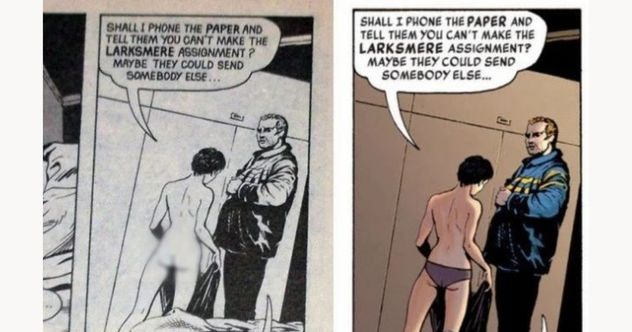
The first issue of Miracleman (2014) was flagged for revision after Alan Moore took over the comic’s authorial duties in 1982, transforming the protagonist into an antihero who became involved in more sinister adventures during the rest of the series’ run. When Marvel Comics gained ownership in 2009, the company’s editor announced the need to make a few changes to the comic’s digital edition.
In the end, two versions of the comic were released, the original and the censored. The former was made available under a 17+ age restriction as Miracleman: Parental Advisory Edition #1 (2014). The reason for the brouhaha? One of its characters had dared to bare their buttocks. In the censored version, underpants have been added.[4]
6 Spider-Woman
When Milo Manara, the well-known illustrator whose drawings tend toward the erotic, posed her in a variant cover for the 2014 issue of Spider-Woman, issue 1, the title character became sexualized. Leaning forward on her hands and knees, her legs apart, the female wall-crawler creeps over the edge of the top of a building, several skyscrapers behind her, suggesting the height of her apparent climb. Her familiar costume, rendered in pastel colors, is more pink and light peach than its standard red and gold.
Although her suggestive posture implies movement, the type of action it is intended to imply is open to interpretation. Enough members of the public saw the possibility of lewdness in Manara’s depiction to protest, and Marvel’s editor-in-chief Axel Alonso, responded with both an apology, explaining that the variant cover was for a limited edition of the comic book meant for collectors. For that reason, the company was okay with retaining the image of Spider-Woman as the artist saw her. Manara’s version of the character was sold at auction to a collector who paid $37,000 for the privilege of owning it.[5]
5 Batman
The first issue in the Batman: Damned series (2018–1019), which appeared in the company’s adult-oriented DC Black Label imprint, shocked readers with its full-frontal nudity. The Caped Crusader appears from the waist down, his nakedness apparent but with details hidden by a dark shadow falling across him in one panel. The only hint of his penis is a few lines, visible despite the shadow, which outline a part of the organ. Based on the feedback the company received from the comic book hero’s fans, DC’s powers-that-be concluded that nudity is not appropriate, even for their mature line of comics.
Future printings of the issue will not include so much as a glimpse of Batman’s genitals, and the digital version of the comic, like those of the printed version, will replace the offending panel of the story with one in which the shadow blocks out all offending parts of his anatomy. Censoring the image was the right call to make, DC admitted, since Batman’s exhibitionism didn’t really add anything to the story.[6]
4 The Authority
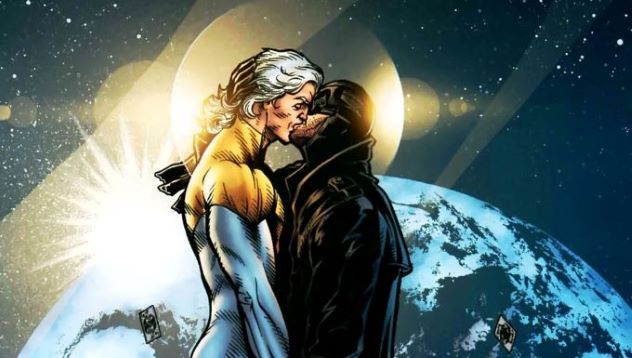
The Authority was originally published by WildStorm, which was owned by AOL/Time Warner from 1990 to 2018, the same company that owned DC Comics during this time period. It was fairly frequently targeted for censorship by DC. Writer Mark Millar and artist Frank Quitely’s inclusion of several characters that were parallels to counterparts in DC’s titles caused much of this censorship. Censored panels were either revised or replaced altogether with new drawings.
In one case, Apollo and Midnighter, it had been implied, might be gay. Their sexuality had never been made explicit, though, until Millar left no doubt that the pair were lovers by allowing them to kiss in issue 27. DC is likely to have censored this act out of concern that Apollo and Midnighter—as characters that paralleled Superman and Batman—might suggest to fans that there was a same-gender relationship between the Man of Steel and the Caped Crusader, which could damage the sales of their titles. A similar reason might have led DC to censor an image of the Engineer, Hulk’s Authority counterpart, flipping off her adversary’s dead body. In the printed version, the British “two-finger [Victory] salute” replaces the Engineer’s raised middle finger.[7]
3 Batman/Catwoman
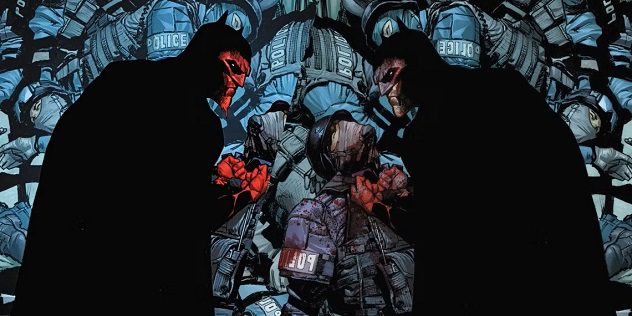
The cover of the seventh issue of Batman/Catwoman (2021) was criticized for its depiction of its protagonist’s bloody face and hands. With the bodies of masked police officers in riot gear heaped and tumbled behind him, Batman clutches one of the fallen by the collar, lifting him from the ground as he stares in anger at the face of the unconscious cop. Against the blue-gray pile of his fellow officers, who are also badly beaten and unconscious, the black silhouette of Batman’s cape and cowl, like his red face and hands, make a stark and dramatic contrast.
Oddly, the revised version of the cover is, if anything, more lurid than the one it replaces. The picture itself is the same. The differences are that the blood does not entirely cover Batman’s face and hands, making him seem masked and gloved. The crimefighter’s face is more visible, as are his hands. The sight of them reveals him to be a man of flesh and blood, rather than a dark, depersonalized avenger.
In the original cover’s illustration, not a single drop of blood has splattered the limp, unconscious body of the police officer whom Batman lifts from the ground or any of his fellow officers. In the censored version, he, like Batman, is bloody, his blood revealing his vulnerability as a victimized human being. In this case, the censorship of the original image results in a much more dramatic and sympathetic portrayal of both Batman and the fallen police officers, showing the humanity beneath their respective costumes and uniforms.[8]
2 Dark Knights of Steel
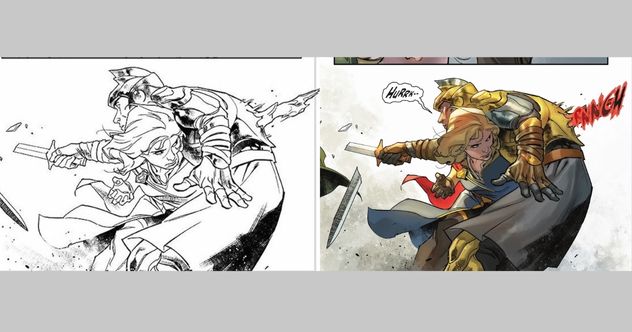
The limited series Dark Knights of Steel (2021–2022), set in an alternate universe to that of Earth’s, unfolds a complex, convoluted plot. Part of it involves Superman’s sister Zala-Jor-El’s avenging the death of Superman’s father, King Jor-El, after Green Man assassinates him at the behest of King Jefferson. Her vengeance takes the form of her own killing of the king’s son before she embarks on a murder spree, during which she kills the alternate universe’s Metal Men with a fury of which only she is capable.
Her slaying of Gold is especially brutal: she thrusts her left arm through him so fiercely that her hand, emerging through his back, is covered in and drips his blood. To censor the extreme violence of the drawing, a sound effect, “RNNGH,” was added to cover her bloody hand.
The same tactic is employed in a subsequent panel, a different sound effect concealing the emergence of the ship’s spar through Jefferson’s abdomen. As Ben Sockol observes, in writing about these censored panels, Zala-Jor-El, unlike her brother, isn’t bothered by moral scruples concerning the commission of acts of violence in the interests of personal vengeance.[9]
1 Punisher
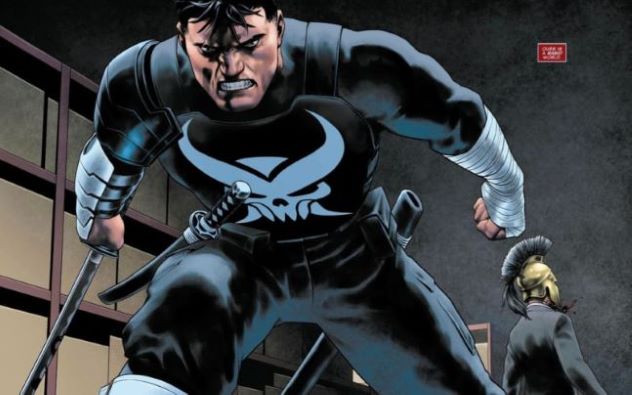
Originally, Punisher was depicted as an unscrupulous, murderous vigilante. In 1974, when he made his debut, and for the last two decades of the twentieth century, such a character was not altogether unacceptable. Crime, including murder, was on the increase, and drug abuse was rampant. The fact that Punisher was himself a victim of crime also made him sympathetic. As times changed, the antihero became an increasingly unfavorable and less bankable character. The Punisher’s weapon of choice, an M16 automatic rifle, also puts him at odds with a growing number of people concerned about gun violence, as does his oft-demonstrated willingness to kill his adversaries.
In 2021, Marvel began seeking to “reboot” the character by adding horns and tusks to the white skull logo he wears on his black shirt to make it resemble the Japanese demon known as an oni and by having Punisher fight his battles without the aid of his trusty M16 rifle or other guns. His fans may not be on board with these censorious revisions. Screen Rant’s senior writer Francesco Cacciatore, for one, is not convinced that Marvel’s modifications of the character’s costume and character will succeed. The company’s efforts to make Punisher more appropriate for today ignore the fact that “the character, as he was originally conceived, is simply not suitable for these times.”[10]








